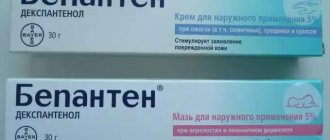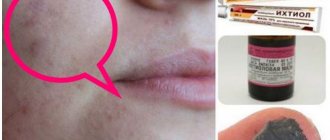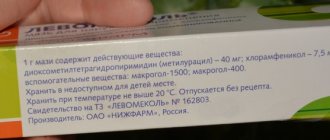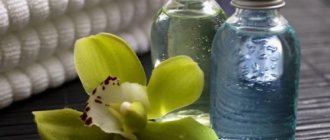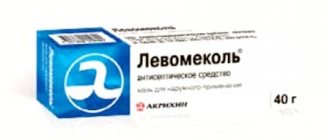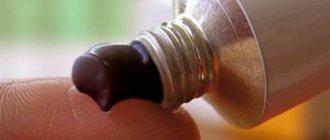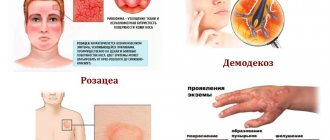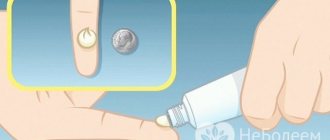Interaction with other drugs
It is strictly not recommended to use it together with other external agents.
The medication combines well with Voskopran. This bandage does not stick to the surface of damaged skin.
At the initial stage, it is applied very tightly to it, and as the properties of Levomekol weaken, it begins to gradually lag behind. When healing is complete, the bandage will easily come off the wound.
Levomekol
- a drug for external use with antibacterial, regenerating and anti-inflammatory effects. The product is available in the form of a white, sometimes yellowish ointment, in metal tubes (40 g) or jars (100 g).
Composition and therapeutic effect of Levomekol ointment
Levomekol is a combination drug that contains two active ingredients:
- Chloramphenicol. Broad spectrum antibiotic. Effective against most gram-negative and gram-positive bacteria, E. coli, spirochetes, chlamydia.
- Methyluracil. An immunostimulating agent with anti-inflammatory properties, which also accelerates the process of cellular regeneration.
- As auxiliary agents, the ointment includes polyethylene oxides (400 and 1500), which promote uniform application of the ointment and its penetration into tissues.
Levomekol has a predominantly local effect (absorption into the blood is extremely insignificant) and can be used regardless of the presence of pus and the number of pathogens. The therapeutic effect lasts 20-24 hours after application of the drug.
Indications for use of Levomekol ointment
The drug is characterized by pronounced antimicrobial activity, helps reduce inflammation, swelling, cleanses inflamed wounds of pus and speeds up tissue healing.
Levomekol is used as one of the main medicines:
- for purulent wounds, including those infected with mixed microflora;
- for burns of 2 and 3 degrees;
- for bedsores and trophic ulcers;
- during treatment;
- for pustular skin lesions;
- for herpes (in case of acute inflammation and suppuration of ulcers);
- with purulent inflammation of the external auditory canal and sinusitis;
- in the treatment of anal fissures;
- with cracked nipples;
- in gynecology for colpitis, inflammatory erosion.
In addition, the ointment is used as a prophylactic agent to accelerate healing and prevent infection of wounds, cuts and postoperative sutures (including vaginal ones).
The list of indications for use of Levomekol ointment is not included. But in the presence of infection or the microbial nature of the disease, the doctor may prescribe Levomekol for the treatment of eczema.
Use of Levomekol for burns
The drug is used to prevent infection and promote healing, usually in cases where burn blisters have burst, after the injured area has been washed with cold water and initial treatment has been carried out. The ointment is applied to a sterile gauze bandage, which is applied to the burn surface and changed 1-2 times a day. The course of treatment can last from 5 to 12 days.
Use of Levomekol for wounds
With an open wound surface, as in the case of burns, the ointment is applied under a bandage. For narrow deep wounds and deep purulent lesions, Levomekol is recommended to be injected into the cavity using drainage or a syringe. For extensive damage, the treatment period should not exceed 5-7 days, since with longer use the drug can negatively affect undamaged cells.
To prevent infection, the most effective use of Levomekol is in the first 4 days after receiving a wound.
Levomekol has contraindications and sometimes causes side effects.
Levomekol (levomecol, levomekol) is an ointment for external use, known for its wound-healing, anti-inflammatory and antibacterial properties. Despite its wide spectrum of action and high efficiency, Levomekol is accessible to everyone. So, what does the remedy help with and why is it so popular?
Levomekol has a wide range of applications
Levomethyl and Levomekol: which is better?
Levomethyl and Levomekol are antibacterial agents that are most often used to treat purulent wounds. They are characterized by antimicrobial and anti-inflammatory properties. They can be used by both adults and children. Even newborns are prescribed drugs.
Levomethyl and Levomekol are antibacterial agents that are most often used to treat purulent wounds.
Characteristics of Levomethyl
This is a combination drug for topical use. The medication belongs to the group of antimicrobial drugs for external use. Its active components are chloramphenicol (an antibiotic) and methyluracil (a regulator of metabolic processes). The drug is presented in the form of an ointment, and is used for various infectious and inflammatory diseases.
Levomethyl has the following properties:
- regenerating;
- anti-inflammatory;
- dehydrating;
- antimicrobial.
The drug penetrates well into tissues without damaging biological cell membranes. The ointment has a bacteriostatic effect and prevents the synthesis of microbial proteins. The drug is effective against the following harmful microorganisms:
- staphylococci;
- Proteus;
- hemophilus influenzae;
- Moraxella;
- streptococci;
- Neisseria;
- shigella;
- salmonella;
- Yersinia.
Levomethyl effectively fights even strains resistant to penicillin. Microbial tolerance to the drug develops slowly. The medication helps normalize the exchange of nucleic acids, increase the rate of cell regeneration in the wound, and accelerate the maturation of granulation tissue. The product also has a photoprotective effect, improves leukopoiesis, erythropoiesis, and stimulates local immunity.
Levomethyl is prescribed for the treatment of wound surfaces that have undergone secondary infection.
As indicated in the instructions for use, Levomethyl is prescribed for the treatment of wound surfaces that have undergone secondary infection. Without surgical intervention, only the initial stages of the pathology can be cured. If a purulent-necrotic process has developed, then first remove the damaged tissue, foci of necrosis and purulent melting.
In addition, the medication is prescribed for the following pathologies:
- burns;
- scratches, abrasions, wounds that heal poorly;
- photodermatitis;
- infected skin at the sites of bone fractures.
The ointment is often used for acne with ulcers, acne, and youth rash. Thanks to the use of the drug, the complexion improves, the inflammatory process decreases, swelling and redness, skin tightness, irritation, and itching are eliminated.
As prescribed by a doctor, the medication is used for bedsores on the body, carbuncles, boils, and trophic ulcers that do not heal for a long time. Levomethyl is often used in gynecology, proctology, and phlebology. The ointment is applied to a sterile gauze pad and applied to the surface of the damaged skin. If there is a deep wound, it is filled with napkins soaked in the drug.
Contraindications:
- psoriasis;
- allergic dermatitis;
- mycotic skin diseases;
- eczematous lesion;
- intolerance to active components.
After applying the ointment, adverse reactions in the form of allergies may develop - rash, urticaria, angioedema. The use of a medication by pregnant women is possible if the benefits of its use outweigh the risk to the fetus.
Analogues of the drug: Levomekol, Netran, Levomikon-TFF.
Characteristics of Levomekol
This is a combined product for external use that has regenerating and antibacterial effects. The main components are chloramphenicol and methyluracil. Available in the form of an ointment. The drug has the following properties:
- regenerating;
- antibacterial;
- anti-inflammatory.
The medication is effective against gram-negative microorganisms: Escherichia coli, Pseudomonas aeruginosa and staphylococci.
The action of the drug promotes rapid tissue restoration and wound healing, as well as the elimination of excess fluid in tissues.
The active components of the product activate the production of interferon, which has antiviral properties. Thanks to this, the ointment acquires a pronounced immunostimulating effect.
The active substances can penetrate deep into the layers of the dermis without damaging cell membranes. If a lot of dead cells or pus have accumulated in the wound, then the effectiveness of the remedy does not decrease.
Indications for use:
- 2nd and 3rd degree burns;
- purulent wounds;
- sinusitis;
- postpartum sutures;
- purulent otitis;
- haemorrhoids;
- trophic ulcers, bedsores;
- postoperative complications;
- swelling;
- inflammation of the oral cavity;
- acne, pimples.
The ointment is good at curing ulcers that fester due to herpes. It is used for cystitis, balanoposthitis, lymphadenitis, after childbirth for ruptures and cracks. The medication effectively eliminates inflammation in the oral cavity, reduces tissue swelling and relieves pain during tooth extraction and implantation.
Contraindications include allergies or hypersensitivity to the components of the drug. Use with caution during pregnancy and breastfeeding. According to the instructions for use, the ointment must be carefully filled into necrotizing areas of purulent wounds.
Side effects:
- dermatitis in the area of application;
- hives;
- itching;
- burning;
- hyperemia;
- local swelling.
Some patients report general weakness. If vaginal tampons are used, candidiasis may develop.
Drug analogues: Netran, Levomethyl.
Patient reviews of Levomethyl and Levomekol
Marina, 39 years old, Izhevsk: “I recently stepped on a board with a nail. Although the shoe saved me a little, it left a good hole in my heel. The wound was narrow and deep. It did not heal for 2 days and began to break out, after which I decided to apply Levomethyl ointment. The inflammation went away quickly, and the wound dried up literally before our eyes.”
Alexey, 26 years old, Samara: “I recently removed a tooth, the surgeon recommended putting a tampon with Levomekol ointment in the socket as often as possible. I tried to apply it carefully, but I still felt bitterness in my mouth. The main thing is that the wound healed quickly. There were no side effects."
Source: https://bur-agregat.ru/gemorroj/levometil-i-levomekol
Instructions for use of Levomekol
The method of applying the ointment will differ depending on the disease or type of tissue damage.
Wounds, stitches, burns
Before using the product, the wound and the skin around it are treated with an antiseptic.
Next, apply a generous layer of the ointment itself and cover it with a clean gauze cloth. It must be removed after 2-4 hours. The procedure is repeated twice a day.
Before applying Levomekol, treat the wound or burn with an antiseptic
For burns, the medicine is not applied to the wound itself, but to a gauze bandage, which is then attached to the affected area.
Haemorrhoids
Levomekol is effective only during the acute stage of the disease. For hemorrhoids, the ointment should be applied before bed. Even if the signs of the disease have disappeared after several uses, the course of treatment is 10 days. At the same time, you can also use special suppositories if hemorrhoids affect not only the external, but also the internal part of the anus.
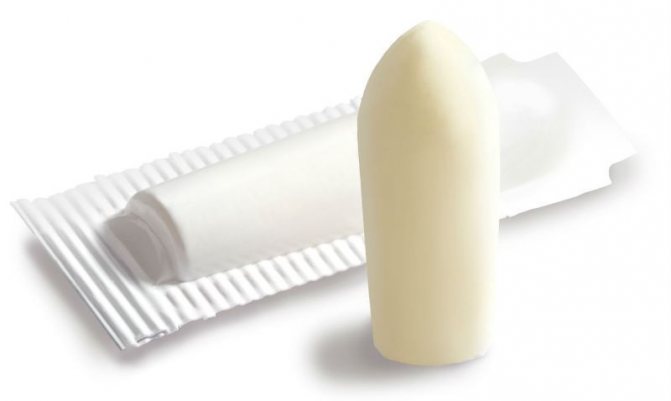
To treat hemorrhoids, you can combine Levomekol and suppositories for hemorrhoids
Gynecology and urology
In gynecology, the medicine is prescribed for purulent wounds and to speed up the process.
Before use, a woman must:
- Wash thoroughly.
- Treat the seams with a non-concentrated solution of potassium permanganate or furatsilin.
- Gently pat the perineum dry with a napkin or towel.
- Allow the skin to dry completely.
- Apply ointment to the gauze and apply it to the seams.
- Put on clean underwear (if necessary, use a pad).
The bandage is removed after 2 to 6 hours.
Levomekol is used to treat erosion, bacterial vaginosis, and various inflammations. The drug is applied to small cotton swabs, which must be carefully inserted into the vagina before bed and left overnight. For ease of removal, the tips of the tampon should be left outside. The duration of treatment is determined by the attending physician.
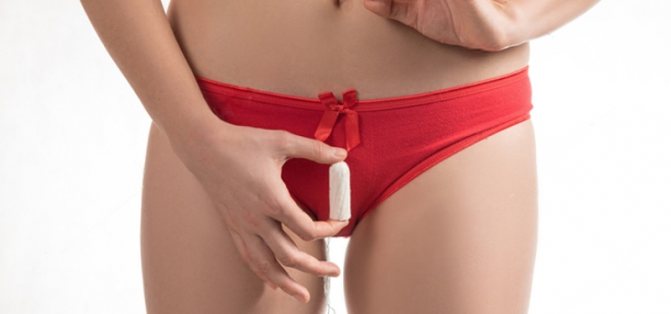
To treat gynecological diseases, you can use a cotton swab with ointment
In urology, Levomekol is used as one of the components of complex therapy in the treatment of balanitis and balanoposthitis in men. The product should be applied to the skin of the foreskin, thoroughly cleaned of plaque. The most convenient way to do this is with a small piece of gauze folded in several layers.
Stomatitis and periodontitis
The drug must be rubbed into the affected areas with gentle circular movements. The procedure is repeated up to 2-3 times a day. After it is carried out, you must refrain from drinking and eating for 30 minutes.
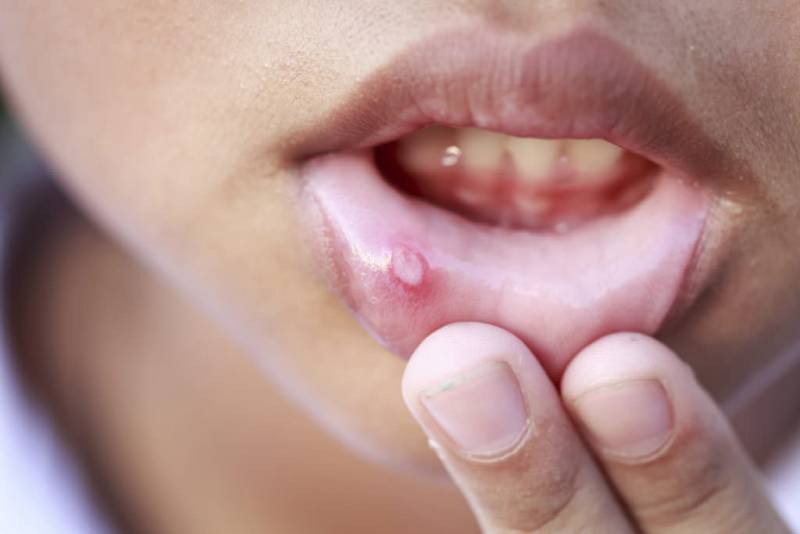
Levomekol is suitable for the treatment of stomatitis
Otitis, sinusitis, conjunctivitis
For sinusitis, the drug is applied to the nose using turundas. It's very easy to make them. It is enough to twist cotton wool or gauze into oblong flagella.
For otitis media, the remedy is used when the external auditory canals become inflamed.
Just as in the previous case, the ointment is administered using cotton buds soaked in it.
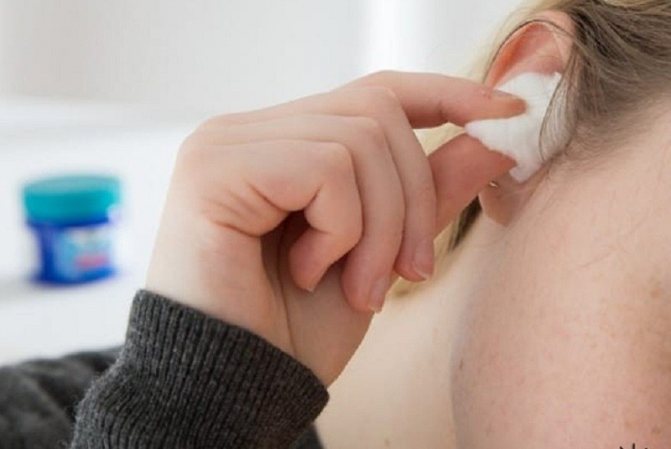
You can treat otitis media using a cotton swab with Levomekol ointment.
Skin problems
Levomekol is used to get rid of boils. Apply ointment to the affected area, cover with a sterile bandage or cotton wool, and bandage it. The procedure is repeated 2 times a day. Under no circumstances should you stop applying the product after the boil has opened!
The principle of action is similar when the patient complains of the presence of abscesses.
The ointment can eliminate acne. It is enough to lubricate the problem area with a thin layer of product once a day and wash it off after 2 hours.

Levomekol can be used to treat acne on the face
Levomekol also saves from calluses. It is best to apply the product before bed and leave it on the skin overnight. This way you can get rid of wet and old dry calluses.
Tattoo
Levomekol is not suitable for tattoo healing. Practice has shown that the product can cause rejection of the coloring pigment. Its use is logical only if the wound has festered.
In other cases, it is better to choose another healing ointment.
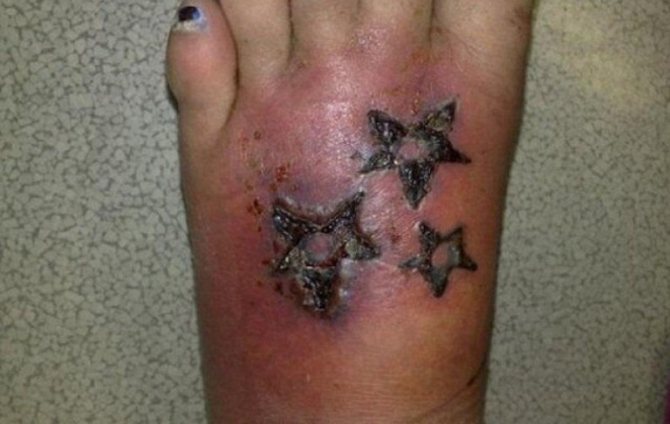
Levomekol should only be used if the tattoo begins to fester
What does Levomethyl ointment help with? Instructions for use
Levomethyl ointment is used in the treatment of various conditions accompanied by wound suppuration. The active substances included in the drug make it possible to use it in various cases. The combined drug has the following effects:
- Antibacterial. The drug Levomethyl is active against staphylococci, streptococci, Haemophilus influenzae, salmonella and other infectious agents.
- Anti-inflammatory. The ointment relieves swelling, inflammation, and redness in the affected area of the skin.
- Regenerating. The medicine restores damaged skin, thereby accelerating healing.
- Necrolytic. The substances included in the drug make it possible to use it in the presence of necrosis. Levomethyl cleanses dead tissue and improves their trophism. The therapeutic effect has a beneficial effect on the treatment of purulent wounds.
The listed properties allow the drug to be used for mild lesions, as well as as part of complex therapy after surgery.
Contraindications and side effects
Restrictions on the use of Levomethyl can be absolute or relative. Absolute contraindications include:
- Skin diseases. This group of restrictions includes fungal skin infections, dermatitis, psoriasis, and eczema. The acute form of the disease excludes the possibility of prescribing Levomethyl.
- The presence of individual intolerance to the components of the drug. The appearance of the first signs of an allergic reaction requires immediate cessation of use of the drug.
Relative contraindications are:
Pregnancy and lactation period
Due to insufficient research on the benefits and harms during this period, Levomethyl is prescribed with caution. Children under one year old. Possible side effects of the medicine include the appearance of redness, itching at the application sites, swelling of the skin
Such symptoms require stopping the use of the drug and contacting a doctor to replace it.
Possible side effects of the medicine include the appearance of redness, itching at the application sites, and swelling of the skin. Such symptoms require stopping the use of the drug and contacting a doctor to replace it.
Reviews from doctors
Yuri Alekseevich Filatov, traumatologist: “There are drugs that should always be in the home medicine cabinet. I even find it difficult to say in how many cases it will help out. Not long ago I prescribed it to a patient with a limited budget and a severe burn. She used only this remedy, and soon her sore spot healed without complications in the form of suppuration and other unpleasant moments.”
Valentina Semyonovna Perets, pediatrician: “Very often, concerned mothers come to me with standard questions. What to do if a child cuts himself, and it’s a pity to cauterize your child, causing even more pain? There is only one answer: for cuts, burns and other damage to the upper layer of the dermis, the drug levomikol is best suited for children. I declare with full responsibility that there will be no harm from it, but only positive dynamics.
Nikolai Petrovich Popik, proctologist: “I often use this remedy in prescriptions. It is literally irreplaceable in my practice. Helps with cracks in the anus and with hemorrhoids is also irreplaceable. There are practically no side effects, so I recommend everyone to use it without fear, even in such a delicate area.
(
1 ratings, average: 5.00 out of 5)
How to use
The drug Levomekol is intended for external use. Let's look at how to use the ointment correctly to get an effective result.
- The ointment is applied in a thin layer to the affected area of the skin, then it is tightly covered with a sterile bandage folded in several layers and fixed. This procedure should be carried out 1 - 2 times a day until the wound is cleared of pus. If the wipes become dirty faster, they should be changed more often (as they become saturated with pus or accumulate necrotic contents). The duration of treatment is 5 - 10 days.
- If the wound affected by pus is large, deep or located in the body cavity, then Levomekol is first applied to gauze napkins that are placed in the wound. Before use, the ointment should be heated to body temperature, then soak gauze pads with the product and insert them into the wound cavity. The number of napkins is determined individually; they should completely fill the wound, but should not be placed tightly.
- For a deep but narrow wound, as well as in cases where its shape and location do not make it possible to insert drug-impregnated wipes, Levomekol is administered with a syringe through a catheter.
- If treatment of the wound surface was missed for any reason, subsequent dressings must be carried out without deviating from the schedule
. - Is it possible to apply Levomekol to bedsores? The drug copes well with bedsores in bedridden patients. To do this, the affected areas should be lubricated several times a day. The ointment is also suitable for the prevention of bedsores. In this case, the skin is treated with medication 1 - 2 times a day.
- The ointment is also used to treat cuts, lacerated or puncture wounds, weeping eczema, torn calluses, and purulent pimples. The principle of treatment is the same as in the cases described above. Purulent pimples are lubricated with a thin layer of the drug at night, and after opening them, the ointment should be placed in the depression formed in the skin. It is also better to perform the procedure at night.
Use of the product in dental practice
To speed up healing, dentists also use the drug. They prescribe the drug to their patients if they need to eliminate the manifestations of a number of unpleasant diseases. This:
- ulcers,
- periodontal disease,
- inflammatory processes of the oral cavity,
- stomatitis and other lesions.
The unique composition of Levomekol ointment helps to minimize pain and allows the patient to soon forget about his problems diagnosed during a dental examination in the clinic.
In addition, dentists use Levomekol after the procedure for installing implants or removing teeth from the dentition. The ointment has a complex effect - it relieves swelling, removes inflammation, and relieves pain. As a result, patients recover quickly and regain the ability to enjoy every day.
What components are included in the ointment?
Levomekol cream can be purchased in aluminum tubes (40 g) or in dark glass jars (100 g or 1000 g). The components of the drug are two active substances - chloramphenicol and methyluracil.
.
Chloramphenicol
is a chemical ingredient that has an antibacterial effect.
Its content per gram of ointment is 7.5 mg. Methyluracil
accelerates the process of wound healing and tissue restoration. 1 g of the drug contains 40 mg of methyluracil.
The popularity of this ointment can be explained by the availability and relatively low price, which for many buyers is often a decisive factor when choosing a drug. Children suffer from colds more often than adults, so parents are constantly on the front line - this is the question of how to resist infection, and if an infection has already occurred, how to quickly deal with this disease.
Use during pregnancy and breastfeeding
Everyone knows that these medications that adults use to fight the virus cannot always be used to treat children. It is also necessary to keep in mind when choosing an antiviral nasal ointment for children. Before purchasing, you should always consult your doctor without treating yourself, especially children. Here is a list of nasal ointments that can be used on children.
The components of the product are also excipients - polyethylene oxide-400
and
polyethylene oxide-1500
.
How does Levomekol ointment differ from other drugs with similar effects? For example, from Levosin. Both drugs are common antibacterial medications. The difference is in the composition: Levomekol consists of two active main components, and Levosin consists of four, but their main antibiotic is the same. Levosin has an additional effect - analgesic and enhanced antibacterial effect. That is why, when choosing analogues, it is necessary to read the instructions.
Oskolin ointment is easy to use in children, it has virtually no contraindications, but it assumes that you want to exclude an allergic reaction to the drug. Viferon is an excellent antiviral nasal ointment for infants. Vishnevskaya ointment is not indicated for children under 6 years of age. At older ages, kidney disease is contraindicated. Ointment "Levomekol" due to the presence of an antibiotic and cannot be used in preschool age.
Even if the ointment is approved for use in children, it is still needed before you see your doctor. Each body is different, diseases occur individually, so there is always a panacea for everyone. Even colds occur differently in all children. One child, despite the heat, is carried around the apartment, and the other is almost entirely in bed, at the same time refusing to eat.
Is there a difference between these drugs and what?
The main difference is the price. Levomethyl is cheaper.
Ointments Levomekol and Methyluracil contain a common active ingredient - methyluracil. Its concentration in the first is 40 mg, and in the second - 100 mg per 1 g of ointment. Levomekol also contains the antibacterial substance Levomycetin, which has a wide spectrum of action and allows its use in the presence of purulent discharge in wounds and in the presence of purulent cavities.
That is, in fact, Levomekol ointment can be used at all stages of treatment of a wound process. First, the antibiotic will help disinfect and clean the wound, and then methyluracil will accelerate regeneration and epithelization.
Methyluracil ointment will be effective only in the absence of pus and discharge, that is, in clean and dry wounds, when they begin to heal. This determines the difference in the use of these drugs.
What is Levomekol ointment used for in medicine? Indications
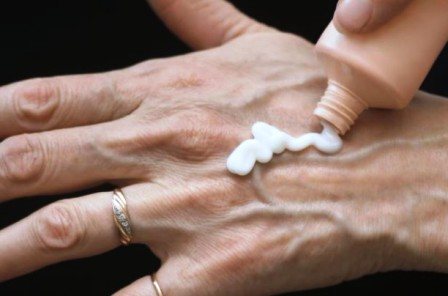
The drug is used as an antimicrobial, anti-inflammatory and regenerating agent. Levomekol ointment is used externally to treat a number of pathologies:
- purulent wounds and ulcers on the skin infected with pathogenic microflora;
- postoperative sutures;
- traumatic skin injuries;
- 2nd and 3rd degree burns;
- trophic ulcers;
- boils, carbuncles, abscesses, pimples, acne;
- calluses;
- bedsores;
- eczema is dry and weeping;
- necrosis;
- frostbite;
- diaper rash;
- prickly heat;
- purulent otitis;
- sinusitis.
Contraindications for use are the presence of hypersensitivity or individual intolerance to the components. Avoid contact of the ointment with the eyes, mucous membranes of the mouth and throat. In such cases, it is necessary to rinse the eyes with plenty of water. If the ointment is accidentally swallowed, the patient's stomach is washed and activated charcoal is given. When treating even very large areas of skin, no cases of overdose or complications were identified.
Application of Vinilin
Vinilin is used for many problems. The instructions for Vinilin say that this medicine is used:
- in dermatology and surgery for the treatment of wounds, abrasions, purulent wounds, injuries, carbuncles, mastitis, furunculosis, trophic ulcers, pustular skin diseases (strepto-staphyloderma), inflammatory skin diseases (dermatitis), cracked nipples, heels...
- for the treatment of varying degrees of severity of thermal and chemical burns, as well as for the treatment of frostbite (also of varying degrees of severity. scabies.
- in dentistry for gingivitis, stomatitis, glossitis, periodontal disease, leukoplakia; negative and irritating effects that occur when using removable plastic dentures;
- sore throat
- in gastroenterology for gastric and duodenal ulcers, gastritis with high acidity, heartburn, colitis, nonspecific ulcerative colitis, Crohn's disease, dysentery;
- in proctology for hemorrhoids, anal fissures,
- in oncology during radiation therapy in the maxillofacial area and with developing post-radiation lesions observed on the mucous membrane of the oral cavity,
Use of Levomekol ointment during pregnancy
The medication can be used both by pregnant women and nursing mothers
. This is explained by the fact that the ointment is used topically and is not absorbed into the bloodstream if the treated area of skin is small. Women during this period of life can treat the following diseases with Levomekol ointment:
In severe cases, they may suffer from more severe symptoms. Any of these symptoms can be fatal to the patient, so treatment for the boil should begin as soon as possible. Not on your own, for diagnosis and treatment it is necessary to be treated by a dermatologist. You should especially not handle independent and popular defenses whenever.
What not to do when there are bruises?
Treatment may require removal of the sweat glands that are causing the recurring inflammation. weakened patients - the patient has serious concomitant diseases. Or he is taking drugs that suppress the immune system. severe - in cases where the ulcer causes severe pain and is accompanied by fever, severe swelling, headache and other symptoms of severe infection. At the same time, collapses are repeated. . As the filling boils, the surface begins to sink, and to speed up the recovery the patient may try to pierce it with a needle or other pointed object to release the pus.
- sinusitis and inflammation of the middle ear and ear canal;
- acne on the skin of both the face and other parts of the body;
- cuts, various abrasions, mosquito bites, minor burns;
- an inflammatory process that develops due to an ingrown nail or after a trimmed manicure.
Analogues of funds
On the pharmacological market, not only Levosin, Levomekol and Levomicon TFF have anti-inflammatory and antimicrobial properties. You can purchase analogues that are also used to heal injured epidermis.
| Drug name | Active substance | Manufacturer | Approximate cost, rub. |
| Baneocin | Bacitracin, neomycin | Pharmaceuticals Fabrik Montavit GmbH, Austria | 160 |
| Betadine | Povidone-iodine | CJSC Pharmaceutical Plant EGIS, Hungary | 150 |
| Heparin ointment | Sodium heparin, benzocaine, benzyl nicotinate | JSC Nizhpharm, Russia | 40 |
| Ichthyolka | Ichthammol | Russian companies | 60 |
| Solcoseryl | Deproteinized hemoderivative | MEDA PHARMACEUTICALS SWITZERLAND GmbH, Switzerland | 190 |
| Syntomycin ointment or Syntomycin | D, L-chloramphenicol | Federal State Unitary Enterprise "Murom Instrument-Making Plant", Russia | 50 |
| Stellanin | Diethylbenzimidazolium triiodite | Pharmpreparat, Russia | 390 |
| Streptocide | Sulfanilamide | Lumi LLC, Russia | 15 |
| Tetracycline ointment | Tetracycline | Russian companies | 40 |
| Oflomelid | Ofloxacin, methyluracil, lidocaine hydrochloride | Sintez AKO OJSC, Russia | 95 |
| Panthenol | Dexpanthenol | Russian and foreign companies | 100 |
| Levomethyl | Dioxomethyltetrahydropyrimidine, chloramphenicol | CJSC "Green Dubrava", Russia | 28 |
When choosing from the drugs Levosin, Levomekol and Levomikon TFF, it is recommended to use the first remedy. This is due to its greater effectiveness and analgesic properties. The product quickly relieves the problem and rarely causes side effects.
Analogues of Levomekol
Synonyms: Levomethyl, Netran.
Analogs of ointments similar in mechanism of action: Levomycetin, Levosin, Lingesin, Protegentina ointment, Streptonitol, Fastin 1.
In gynecology and for hemorrhoids, Methyluracil suppositories can be used as an analogue of the drug in some cases.
Levomekol or Vishnevsky ointment - which is better?
The basis of Vishnevsky's ointment is xeroform, birch tar and castor oil. Levomekol has a local anti-inflammatory and antimicrobial effect, the use of Vishnevsky ointment gives local irritant and antiseptic effects.
Levomekol is prescribed mainly for the treatment of severely inflamed, festering, infected wounds (in the wound inflammation phase). Vishnevsky ointment, according to Wikipedia, is used mainly in the regeneration phase of the wound process: balsamic liniment stimulates tissue repair and granulation in a regenerating wound.
Liniment is contraindicated in cases of unsanitized purulent processes (felon, boil, carbuncle, etc.), however, use in these cases makes it possible to speed up the abscess and cleaning of the wound in the future.
The antiseptic contained in Vishnevsky's ointment penetrates the skin in concentrations insufficient for a bactericidal effect. Tar and castor oil stimulate local blood circulation in the suppurating area and inflammation. The course of the pathological process is aggravated by increased pain, expansion of the purulent cavity and accumulation of exudate.
Vishnevsky ointment is hydrophobic, therefore its use for the treatment of purulent wounds does not allow for normal outflow of wound secretions, and its antimicrobial component is not released and does not have the necessary effect.
Levomekol is a hydrophilic, water-soluble substance. The antibiotic it contains easily transfers from the ointment to the wound. The osmotic activity of the drug is 10-15 times higher than the effect of a hypertonic solution and lasts from 20 to 24 hours. In this regard, for an effective effect on the wound surface, 1 dressing per day is sufficient.
What to choose, Ichthyol ointment or Levomekol?
Ichthyol ointment has keratoplasty, antiseptic, anti-inflammatory and local anesthetic effects.
The product regulates vascular tone and has a beneficial effect on inflamed skin and subcutaneous layers. Indications for the use of “ichthyolka” are skin diseases, arthritis and neuralgia.
Thus, the drugs have different indications for use, which makes their comparison incorrect.
Pharmacological group
Levomekol is an antimicrobial agent. Pharmacological group – antibiotics of the chloramphenicol series. The drug has antimicrobial, anti-inflammatory, dehydration, regenerating effects and is prescribed for the treatment of infected wounds in the first phase of healing.
Pharmacodynamics
Combined ointment Levomekol contains active and auxiliary components that have a complex therapeutic effect in the treatment of purulent-necrotic wounds. Chloramphenicol or chloramphenicol is active against most gram-positive and gram-negative bacteria, which cause inflammation with the formation of purulent exudate.
Levomycetin has a bacteriostatic effect - it suppresses protein synthesis in the cells of pathogenic microflora, which leads to disruption of the life cycle of bacteria. Methyluracil activates local immunity, has an anti-inflammatory effect, promotes rapid regeneration of damaged cells and tissue scarring.
Excipients have an anti-edematous effect, which reduces the accumulation of inflammatory exudate in the area of inflammation. The polyethylene oxide base enhances the therapeutic effect of the active ingredients in the drug. The activity of the ointment does not decrease in the presence of pus, blood clots, or necrotic masses.
Pharmacokinetics
Levomekol is well absorbed into the deep layers of the skin without damaging biological cell membranes. With prolonged use and application to large areas of the skin, it can be absorbed into the general bloodstream and have a systemic effect on the body.
Which suppositories for hemorrhoids are best used in complex treatment
There is an opinion that since the rectum is very close to the prostate, hemorrhoids can cause impotence.
However, experts say that the presence of hemorrhoids alone cannot lead to erectile dysfunction.
Remedies that will alleviate the condition of hemorrhoids most often include hemorrhoid ointments and rectal suppositories. Tablets for hemorrhoids are also used in complex treatment. In addition, there are various exercises for hemorrhoids that can have a positive effect on the patient’s condition.
The question of which suppositories for hemorrhoids is best to use, of course, should be answered first of all by your attending physician. The use of various rectal suppositories depends on the degree of development of the disease, as well as the presence of individual contraindications.
In no case should you neglect a visit to the doctor and try to get advice on the question “which suppositories are best for hemorrhoids” from a pharmacist at the pharmacy, since at best, if you make the wrong choice, you can expect an allergic reaction. Below we will take a closer look at some types of rectal suppositories so that you can get an idea of which suppositories are best for hemorrhoids to use. But it is worth remembering that you should not use any of these drugs without consulting a specialist.
Compound similarities
The composition of Levomethyl and Levomekol is identical, and they have the same effect on the body. These are antimicrobial and anti-inflammatory agents for external use. They are used to treat wounds. Release form: ointment.

Which medication to choose is determined by the doctor individually in each case, assessing the patient’s condition.
Contraindications
Levomekol ointment, according to the instructions, is well tolerated by patients. Its use is prohibited only in case of thrush and individual intolerance to the components of the product. If allergic reactions develop during use, use should be stopped and consult a doctor.
Indications, contraindications and method of application
If the affected area of the nose, the auditory canal, the area of the nasolabial triangle, even with one element, the patient has the following symptoms: headaches. Because it increases swelling and spreads to one or both nostrils, cheeks, upper lip. Due to severe swelling, the patient may experience shortness of breath. When an abscess occurs, there is a lot of purulent discharge, usually red, because the nasal mucosa is well supplied with blood and there is no vascular damage. After the disorder, the patient's ulcer condition improved significantly, the temperature dropped, and the pain disappeared.
